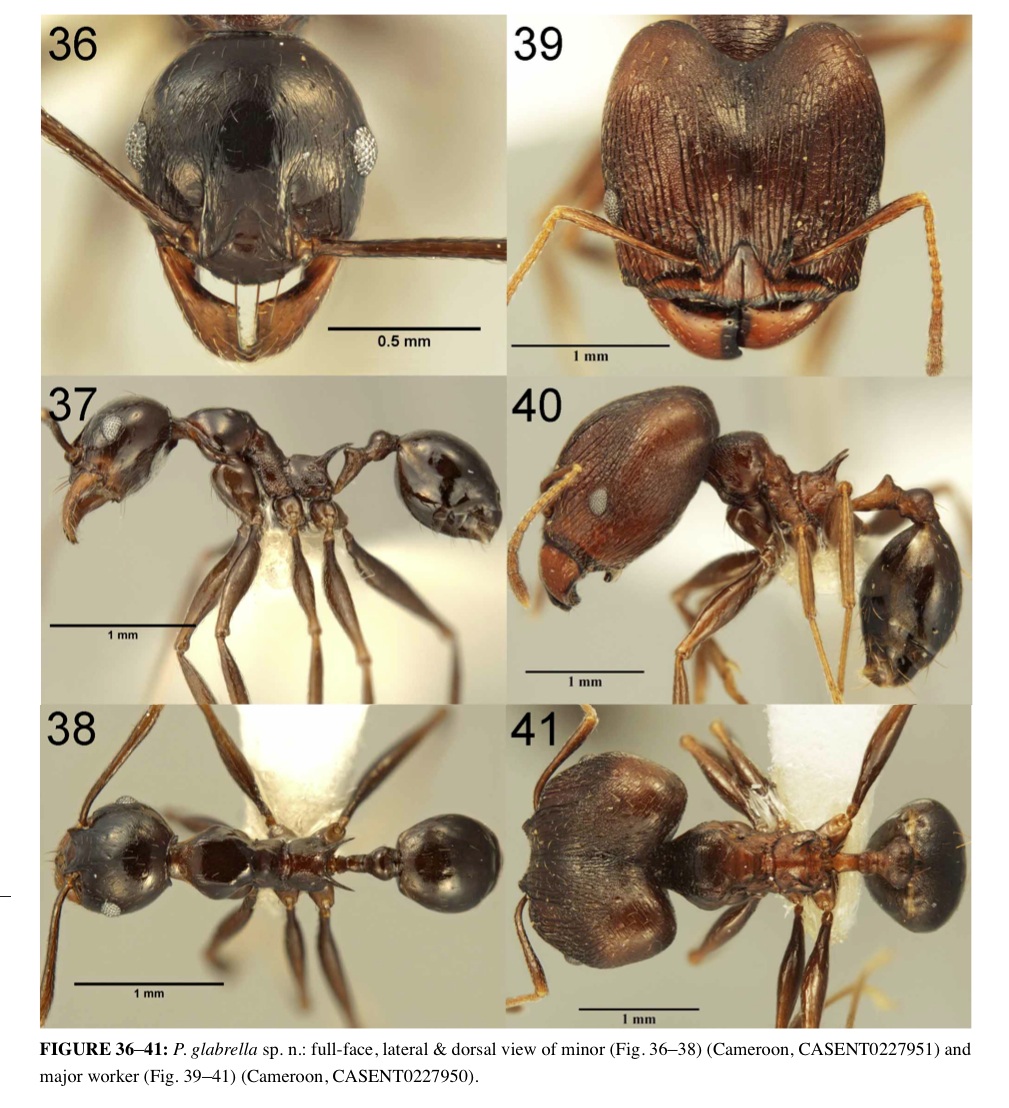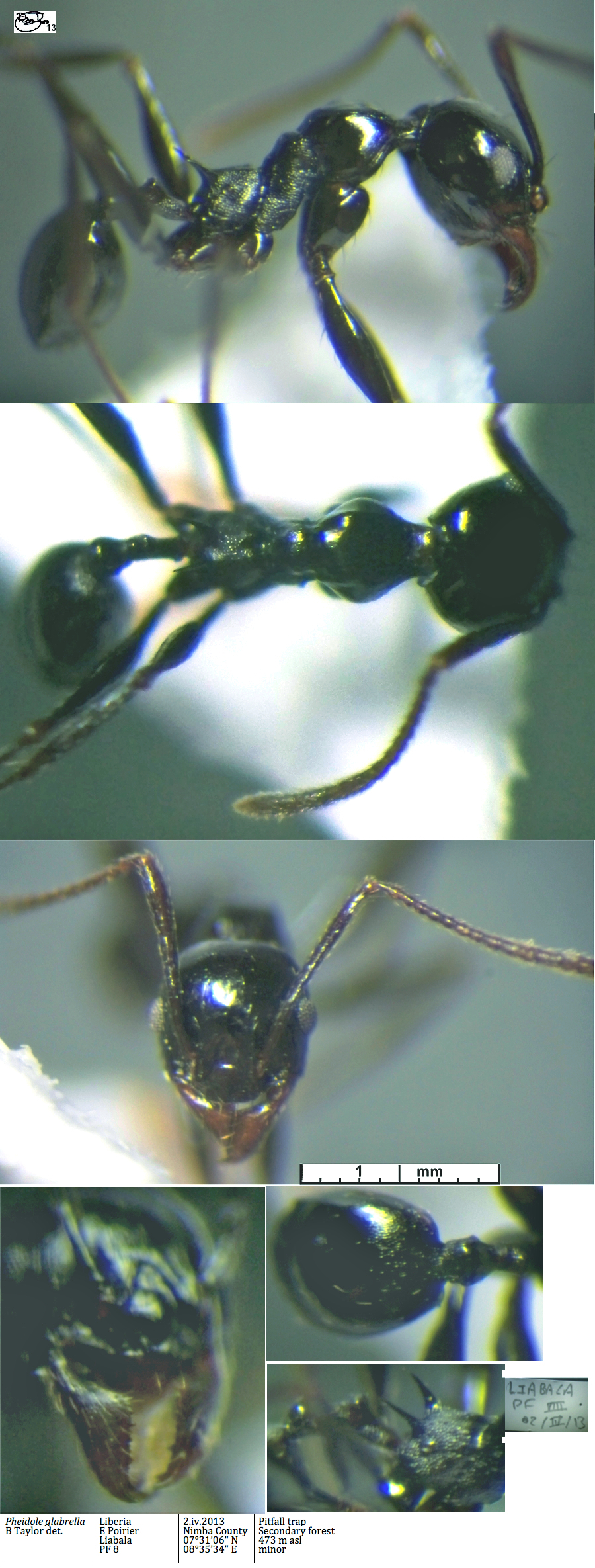Pheidole glabrella Fischer, Hita Garcia &
Peters
  Type location Cameroun
(Fischer, Hita Garcia & Peters, 2012: 26, Figures 36-41); holotype
(major worker) CAMEROON, Ebodije, 4.xi.91 (A. Dejean) (BMNH:
CASENT0227950) - images not available on Antweb (November 2014). Type location Cameroun
(Fischer, Hita Garcia & Peters, 2012: 26, Figures 36-41); holotype
(major worker) CAMEROON, Ebodije, 4.xi.91 (A. Dejean) (BMNH:
CASENT0227950) - images not available on Antweb (November 2014).
 . .
|
Paratypes: (2 major workers, 6 minor workers) same data
as holotype (BMNH: CASENT0227951, CASENT0227952, CASENT0227953).
Diagnosis: Colour
reddish brown to dark brown. Minor workers: head shape
broadly rounded, with rounded to slightly compressed posterior head
margin (CI 88–95). Scapes short to moderately long (SI 123–141) with
appressed to decumbent pilosity. Promesonotum and parts of meso- and
metapleuron smooth and shiny to superficially punctate, second
mesonotal process usually shallow, spines relatively long and massive
(PSLI 28–40). Pilosity on metatibia mostly appressed, standing hairs
scarce to practically absent from dorsum of entire body, completely
absent from alitrunk [mesosoma]. Major workers: head irregularly
rugose-punctate, rugae of varying lengths, punctures weak to
superficial with smooth areas between rugae. Scapes relatively short
(SI 49–53), with appressed pilosity. Pronotum irregularly and
transversely rugulose, declivity smooth and shiny. Metanotal groove
broad, in profile view, dorsopropodeum anterior to propodeal spines
shorter than horizontal width of base of spines. Metatibia pilosity
fully appressed, standing hairs rare, absent from alitrunk.
|
Description of major
worker: Some rugae on frons long and others short or
interrupted,
posterolateral lobes weakly and obliquely rugulose-punctate to smooth
on corners or weakly reticulate. Sides of head laterally of antennal
scrobe weakly rugose-reticulate or irregularly rugose, punctures weak
to superficial and sometimes smooth areas present between sculpture.
Scapes relatively short (SI:49–53), with appressed pilosity.
Promesonotum in lateral view in some specimens short, dorsally nearly
flat and posteriorly slightly compressed, with steep and long
declivity, in other specimens longer and rounding into posterior
declivity. Anteropronotum dorsally and laterally with irregularly
distributed transverse rugulae, in between with weak to superficial
punctures, grading to smooth and shiny promesonotal declivity dorsally
and posteropronotum laterally. Humeral area laterally weakly processed
and angulate, mesonotal process shallow to well-produced, dorsally
smooth with oblique angle or right-angled and steeply declining. Second
mesonotal process inconspicuous, at most visible as weak ridge,
metanotal groove broad and shallow. Dorsopropodeum very short and in
profile view anterior to propodeal spines significantly shorter than
horizontal width of base of spines, weakly punctate, but with dense
punctures lateroventrally. Meso- and metapleuron weakly to super-
ficially punctate, smooth and shiny around metapleural carina,
metapleural gland scrobe absent or inconspicuous. Transverse rugula(e)
present posteriorly between spines, posteropropodeum otherwise weakly
punctate. Metatibia with fully appressed pilosity. Petiole (except
anterodorsally) and postpetiole punctate to weakly punctate, the latter
posterodorsally with weak irregular rugulae. First gastral tergite
shagreened, posteriorly hexagonally microsculptured. Long standing
hairs very rare on head, postpetiole and dorsal gaster, their apices
blunt or truncate, on alitrunk completely absent. Color reddish brown,
gaster dark brown.
Measurements (holotype): HL 1.800, HW 1.800, SL 0.956, MDL 0.778,
EL 0.222, MFL 1.397, MTL 1.067, WL 1.349, PSL 0.311, PTH 0.300,
PPH 0.333, PTL 0.489, PPL 0.300, PTW 0.200, PPW 0.411, PW 0.744
Indices: CI 100, SI 53, MDI 43, PSLI 17, PWI 41, FI 78, PeI 27, PpI 55,
PpWI 206, PpLI 163.
Measurements (n=5): HL 1.820–2.125 (1.974), HW 1.840–2.150 (2.015),
SL 0.944–1.078 (1.024), MDL 0.778–0.967 (0.878), EL 0.228–0.267
(0.246), MFL 1.429–1.635 (1.537), MTL 1.089–1.270 (1.192), WL
1.381–1.619 (1.524), PSL 0.311–0.367 (0.342), PTH 0.300–0.356
(0.333), PPH 0.344–0.444 (0.392), PTL 0.467–0.567 (0.536), PPL
0.311–0.344 (0.329), PTW 0.200–0.261 (0.232), PPW 0.428–0.544
(0.483), PW 0.800–0.944 (0.880)
Indices: CI 99–105 (102), SI 49–53 (51),
MDI 42–45 (44), PSLI 16–18 (17), PWI 42–44 (44), FI 75–79 (76),
PeI 24–28 (26), PpI 50–59 (55), PpWI 186–222 (209), PpLI 145–170
(163).
|
Description of
minor
worker: Head shape in full-face view posterior of eyes roundly
convex to
compressed, posterior margin rounded to weakly flat (CI 88–95).
Occipital carina narrow, mandibles smooth and shiny dorsally. Clypeus
without or rarely with short submedian carinae and with inconspicuous
and short lateral carinae. Face smooth with hexagonal microsculpture,
weakly to superficially punctate laterally near eyes, malar carinae
weak, disappearing posterior of eyes. Scape, when laid back, surpassing
posterior head margin by more than one quarter of its length (SI
123–141) and with appressed to decumbent pilosity. Promesonotum in
lateral view flat and subangular, completely smooth and shiny to
superficially punctate. First mesonotal process conspicuously produced,
with worn appearance, due to complete lack of sculpture, other than
hexagonal microsculpture. Second process shallow and worn, very rarely
more conspicuous. Mesopleuron and propodeum weakly to superficially
punctate to almost smooth, intensity also varying with viewing-angle.
Episternum, anterior lateropropodeum, and dorsopropodeum often with
smooth spots, metapleural carina and gland scrobe developed. Spines
mostly very long (PSLI 28–40), relatively massive basally, short
rugulae radiating medially and posteroventrally from their bases.
Metanotal groove conspicuously U-shaped in lateral view. Metafemur
moderately to relatively long (FI 143–170), metatibial pilosity
appressed. Petiole and postpetiole punctate laterally and ventrally,
peduncle and nodes dorsally polished smooth. First gastral tergite
shagreened anteriorly, grading to smooth and shiny posteriorly.
Alitrunk lacking long standing hairs dorsally, but moderately long
hairs present on posterior end of gaster, in some specimens also on
anterior gaster and on head. Head or postpetiole or both with
additional appressed inconspicuous pubescence, sometimes with very few
short decumbent to subdecumbent hairs. Color reddish brown, appendages
and head margin near lateral base of mandibles in lighter shade.
Measurements (n=26): HL 0.722–0.922 (0.851), HW
0.667–0.856 (0.779),
SL 0.876–1.133 (1.022), MDL 0.511–0.633 (0.576), EL 0.167–0.194
(0.181), MFL 1.044–1.349 (1.224), MTL 0.789–1.044 (0.951), WL
1.011–1.286 (1.162), PSL 0.200–0.356 (0.282), PTH 0.167–0.206
(0.185), PPH 0.183–0.239 (0.212), PTL 0.267–0.367 (0.336), PPL
0.178–0.233 (0.198), PTW 0.106–0.133 (0.121), PPW 0.183–0.267
(0.225), PW 0.456–0.557 (0.506)
Indices: CI: 88–95 (92), SI 123–141 (131),
MDI 71–78 (74), PSLI 28–40 (33), PWI 61–68 (65), FI 143–170 (157),
PpWI 165–210 (186), PpLI 142–206 (170).
|
Discussion:
Minor
and major workers show a relatively great degree of variability in size
and sculpture, especially between the type specimens from Cameroon and
the material from the Central African Republic and Gabon. Minors from
the Central African Republic differ from the types in a more variable
sculpture on the mesonotum, mesopleuron and propodeum. The latter is
almost smooth in some specimens versus strongly punctate in others. The
minor workers of the type series possess a smooth mesonotum and
superficially sculptured mesopleuron and propodeum. Majors from Gabon
are differentiated from the type majors by the absence of punctate
sculpture between the rugae on the head, and in lateral view a longer,
rounded promesonotum. They are also more than 10 percent larger than
the majors from the type series, although the indices are not
significantly different between the two populations. Other than these
differences, all specimens share the same morphometric profile and
overall habitus. This, and the fact that intermediate forms are present
in the minor subcaste, is in support of a one-species hypothesis.
Still, there is a small probability that the different populations
could turn out to be heterospecific, if more material from other sites
and particularly from the major worker subcaste becomes available.
The species most similar to Pheidole
glabrella is P. rebeccae.
The minor workers of the latter are separated from those of the former
by a slightly less convex posterior head margin, and shorter scapes
(SI 114–121 versus SI 123–141), spines (PSLI 25–30 versus PSLI
28–40) and legs (FI 133–139 versus FI 143-170). The major workers of P. rebeccae differ from those of P. glabrella
by longer and uninterrupted rugae in the face, a narrow versus broad
metanotal groove, and significantly more standing hairs on all dorsal
surfaces, except the propodeum. P.
glabrella
has a West to Central African distribution, from Cameroon to the D.R.
Congo, where several minor workers were collected by the American
Museum Congo Expedition together with and included in the type series
of P. batrachorum. The other
material has been collected in rainforests from sifted leaf-litter,
rotten logs, and beating of the lower vegetation.
Additional material
examined: CAMEROON: (7 minor workers) Prov. Sud,
P.N. Campo, 43.3 km 108° ESE Campo, 290 m, 7.iv.2000, 02° 17.0’ N, 10°
12.4' E (B.L. Fisher); (1 minor worker) Mbalmayo, xi.1993 (N. Stork);
CENTRAL AFRICAN REPUBLIC: (1 minor worker) Reserve Dzanga-Sangha, 12.7
km 326° NW Bayanga, 03° 00.27' N, 16° 11.55' E, 420 m, 11–17.v.2001 (S.
van Noort); (2 minor workers) P.N. Dzanga-Sangha, 38.6 km 173° S
Lidjombo, 02° 21.60' N, 16° 03.20' E, 350 m, 21–27.v.2001 (S. van
Noort); (1 minor worker) P.N. Dzanga- Ndoki, 21.4 km 53° NE Bayanga,
03° 02.01' N, 16° 24.57' E, 510 m, 3.v.2001 (S. van Noort); (5 minor
workers) Reserve Dzanga-Ndoki, Mabea Bai, 21.4 km 53° NE Bayanga, 03°
02' N, 16° 25' E, 510 m, 1–07.v.2001 (B.L. Fisher); (2 minor workers)
Reserve Dzanga-Ndoki, 37.9 km 169° S Lidjombo, 02° 22' N, 16° 10' E,
360 m, 21.v.2001 (B.L. Fisher); (1 minor worker) Reserve Dzanga-Sangha,
12.7 km 326° NW Bayanga, 03°00' N, 16° 12' E, 470 m, 10–17.v.2001 (B.L.
Fisher); D.R. CONGO: (5 major workers, among syntypes of P.
batrachorum) Akenge (H.O. Lang); GABON: (2 minor workers) Prov.
Ogooue
Maritime, Reserve Moukalaba, 12.2 km 305° NW Doussala, 110 m, 02° 17.0'
S, 10°29.8' E, 24.ii.2000 (B.L. Fisher); (5 minor workers) Prov.
Woleu-Ntem, 31.3 km 108° ESE Minvoul, 02° 04.8' N, 12° 24.4' E, 600 m,
12.ii.1998 (B.L. Fisher); (2 major workers, 4 minor workers) Prov.
Ogooue Maritime, Reserve Monts Doudou Moukalaba, 12.2 km 305° NW
Doussala, 110 m, 02° 17.0' S, 10° 29.8' E, 24.ii.–3.iii.2000 (B.L.
Fisher); (1 minor worker, 1 major worker) Prov. Ogooue Maritime,
Reserve Monts Doudou, 25.2 km, 304° NW Doussala, 02° 13.60' S, 10°
23.70' E, 14.iii.2000, 640 m (B.L. Fisher).
|
 Illustration from
Fischer, Hita Garcia & Peters (2012). Illustration from
Fischer, Hita Garcia & Peters (2012).
|
Oxford University Museum
specimens
Pheidole glabrella
B Taylor det. |
Liberia
E Poirier
Liabala
PF 8
|
2.iv.2013
Nimba County
07°31’06" N
08°35’34" E
|
Pitfall trap
Secondary forest
473 m asl
minor
|
2
|
 |
Pheidole glabrella
B Taylor det.
|
Cameroun
G Debout & A Dalecky
Cameroon 09
|
24.iii.2001
TM
2°34.04' N
9°50.64' E
|
on soil and surface
in forest understorey
|
2
|
 |
Pheidole glabrella
B Taylor det. |
Central African Republic
P Moretto
1-2.iii.2012
|
Sangha
PN Ndoki
02˚28'39" N
22˚01'20" E
|
06-05
Camp 1, forêt dense diversifiée, piège iule
minor worker
|
1
|
 |
|
 The photomontage is of
minors collected in Cameroun
- south-western tropical coastal forest area between Edéa and Campo
(McKey Wolbachia project, Cameroon 09). The photomontage is of
minors collected in Cameroun
- south-western tropical coastal forest area between Edéa and Campo
(McKey Wolbachia project, Cameroon 09).
My notes as P. pulchella
were: the overall morphology appears to match Santschi & Wheeler's
descriptions of the pulchella minor,
notably the round head and long backward
curved propodeal spines. However, the colour, near black, differs,
perhaps being equivalent to the colour given for the major of
Santschi's (1939b) variety achantella, i.e. more or less dark
red-brown, gaster pitch brown, antennae and legs reddish. There is an
almost total lack of erect hairs apart from a distinct pair projecting
forwards on the clypeus, and the appressed pilosity on the legs and
antennae, which differ from the type. Noticeable also is the clypeus
which, although convex, is depressed below the general level of the
face.
|
 The photomontage is of
a
minor collected in Liberia, Liabala; collector E Poirier
(Liabala PF 8). The photomontage is of
a
minor collected in Liberia, Liabala; collector E Poirier
(Liabala PF 8).
|
 The photomontage is of
a
minor collected in the Central African Republic, Ndoki, Sangha; collector P Moretto. The photomontage is of
a
minor collected in the Central African Republic, Ndoki, Sangha; collector P Moretto.
|
|